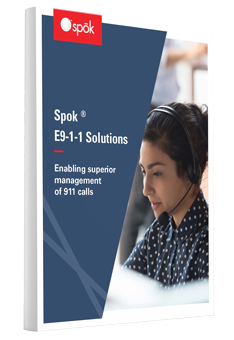Kari’s Law
A change in federal laws may mean a change for you.
Unlike the state-by-state legislation in the past, two new federal laws impact every business with a multi-line telephone system (MLTS).
Kari’s Law, signed by Congress in 2018, requires MLTS to support direct dialing of 911. That is, an MLTS must initiate a 911 phone call without requiring an initial digit, like 9 or 1, first. In addition, to help speed response times when first responders arrive, the MLTS system must notify a central location, like the front desk or security office, where someone is likely to be alerted of the 911 call.
The notifications must include at least:
- An alert that a user dialed 911 from the MLTS
- A callback number
- Information about the caller’s location (for example, a hotel room number)
The FCC does note, however, there may be cases where it’s not possible to provide a callback number or location information. These two parts of Kari’s Law are known as the direct dialing and notification requirements.
Ray Baum’s act
![]() Section 506 of the Ray Baum’s act requires all 911 calls, including those from MLTS, to include the “dispatchable location” to help first responders quickly locate the caller. According to the FCC, “Dispatchable location information includes the street address of the caller and additional information, such as room or floor number, necessary to adequately locate the caller.”
Section 506 of the Ray Baum’s act requires all 911 calls, including those from MLTS, to include the “dispatchable location” to help first responders quickly locate the caller. According to the FCC, “Dispatchable location information includes the street address of the caller and additional information, such as room or floor number, necessary to adequately locate the caller.”
Essentially, the purpose of the Ray Baum’s act is to improve emergency responses by better sharing the precise location of someone calling 911, including when calling from an MLTS.
Compliance dates
The requirements of Kari’s Law took effect on Feb. 16, 2020. The FCC will not invoke consequences for systems installed before Feb. 16, 2020, but any updates, alterations, or new software must meet direct dialing and notification requirements. To comply with Kari’s Law, your organization must ensure you’re meeting the direct dialing and notification requirements outlined above.
Depending on the type of MLTS device (fixed or non-fixed, on-premise or off-premise), the Ray Baum’s act compliance deadlines start on Jan. 6, 2021. To comply with Section 506 of the Ray Baum’s act, your organization must deliver the dispatchable location to the public safety answering point (PSAP) with any 911 call, including those from MLTS.
Read more about Kari's Law and The Ray Baum's Act on our blog >>
Spok E9-1-1 solutions
- Links to call recording module
- Supports mixed PBX environment
- Monitors dedicated 911 trunks for proper operation
- Generates emergency call activity and hardware alarm reports
- Meets or exceeds enhanced 911 compliance legislation
Update the ALI database for fixed and non-fixed devices
Locating a 911 caller is based on having accurate information in the public location database, known as the automatic location identifier database (ALI). When you place a 911 call, your location is passed to the emergency call-takers. Some organizations may not realize that maintaining accurate information in this ALI database is their responsibility. Spok takes care of this by tracking and maintaining your organization’s moves, adds, and changes and automatically updating the ALI database accordingly.
Many organizations today are using voice over Internet protocol (VoIP) telephony. This technology gives rise to the unique challenge of tracking wired and wireless IP phones, which are designed to be easily mobile throughout an organization. Track non-fixed devices, allowing individuals to change the location of their phone but still be identified. Within a VoIP environment the system is notified of any changes in caller location. It then ensures that the caller ID sent to the PSAP represents the most current caller location based on the ALI database record accessed.
Integrate off-premises devices
Within large enterprise networks that use multiple PBXs and/or remote shelves, a main PBX is usually designated as the primary interface with the public switched telephone network (PSTN). The remaining PBXs and/or remote shelves route net calls to the designated primary PBX. These enterprise networks can become very large and result in the physical locations of PBXs/remote shelves residing in different PSAP jurisdictions, or even in different 911 networks, than that of the main PBX. The advent of VoIP has further increased the geographical networking capabilities, and remote IP phones may be deployed great distances from the main PBX. An IP phone’s access to the main PBX may be over the enterprise’s intranet or over the public Internet via a VPN (or a combination of the two).
The result of this geographical spread is that 911 calls that are routed through the main PBX may not be routable or transferrable to the correct PSAP, making automatic identification of the 911 caller’s location impossible.
A virtual E9-1-1 integration feature provides a solution for these off-premises devices. This solution also extends the availability of the all E9-1-1 features to the remote sites.
Database integration
Spok E9-1-1 solutions are programmed to access a database behind the private switch/switch network with every customer/station. Location information is critical to this application, specifically for when the PSAP dispatches emergency response units. The Database Integration Module is a passive link from the existing database system to the E9-1-1 system that provides up-to-date number and location information for the 911 call-takers.
Notification
Providing on-site notification of a 911 caller’s number and location information helps ensure E9-1-1 system integrity for business telephone systems and provides the same E9-1-1 functionality available to residences. This translates and transmits critical information to the E9-1-1 network and to on-premise dispatch systems.
Passive monitoring
An additional level of 911 caller intervention can supply the nature of the call (e.g., medical, fire, HAZMAT, or prank) by monitoring the voice segment of the call. You have the capability to supervise a 911 call in “monitor only mode.” Security or other appropriate personnel can listen to the voice segment of the call without “blocking” or interfering with the flow of the 911 call.
Passive monitoring allows security officers to listen to a 911 call in progress, thereby enabling them to assess the situation and respond accordingly. By understanding the situation, they can provide immediate help like providing first aid, handling crowd control, or directing emergency first responders. In the case of a sick or injured individual, both organization officials and emergency personnel need to rush toward the situation. In a situation that threatens employee safety, staff and visitors must be rushed away from the scene.
Call recording
Each recorded session is marked with the time, date, and identification of the calling party. The recorded files are stored locally for easy access and playback needs. The recorded files can also be emailed to administrators.
Meet and exceed E9-1-1 compliance legislation
It’s important to understand how compliance legislation fits into the E9-1-1 picture. Spok has extensive experience in helping customers comply with both state and federal regulations. While it’s necessary for your organization to seek advice from legal counsel familiar with state and federal laws, our E9-1-1 solutions meet and exceed E9-1-1 compliance legislation for TDM as well as VoIP static and dynamic end points, end point tracking and discovery, nomadic VoIP users, ANI and ALI updates, Kari’s Law, and the Ray Baum’s Act.
The right solution…
Spok® Enhanced 9-1-1 (E9-1-1) solutions give you the tools you need to comply with recent legislation and protect your most valuable asset: your people.
Pinpoint a caller’s exact location
The solutions pinpoint a 911 caller’s location and pass it along to the PSAP. This kind of reliable, automatic transfer of information will help you provide vital, lifesaving information to the public safety network and notify the appropriate on-site personnel that an emergency call is in progress. Ultimately, this speeds response for the 911 caller.
Notify on-site staff in real time
E9-1-1 software from Spok provides real- time, on-site notification when a caller dials 911 from your facility. With this feature, on-site personnel get a quick snapshot of what’s happening and provide valuable first responder assistance—instead of just waiting for the 911 team to arrive. This kind of alert may mean the difference between life and death.
You’ll also be able to notify many different locations about the 911 call. Easily alert staff at a security desk, guard shack, attendant location, or any other desired location in the enterprise. Spok also provides flexibility in how you notify people because it supports phones, pagers, wireless devices, or screen pops to computers.
Screen pops not only alert on-site staff, but they also provide specific information about a caller or location, such as a critical medical condition or the presence of hazardous materials. This extra information allows on-site personnel to better assist emergency responders when they arrive.
…from the right company
Spok has been helping organizations like yours automate, centralize, and standardize mission-critical communications for decades. With thousands of enterprise-level installations currently in place, our proven technology platform, applications, and expert services support many of the most vital communication systems and processes in the world. If you’re ready to learn more, please connect with us.




